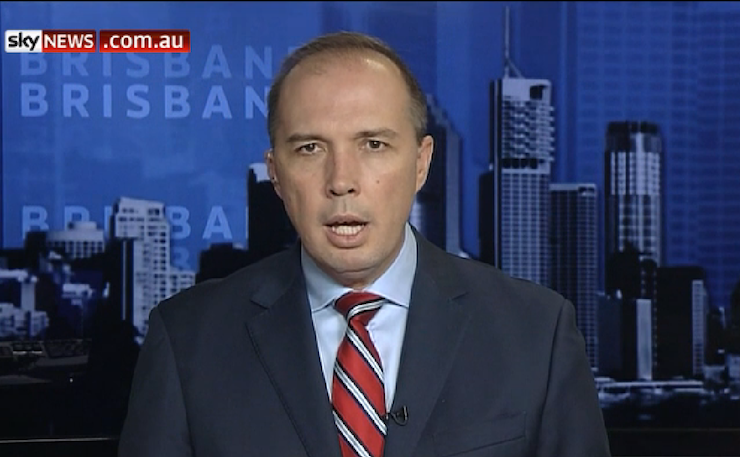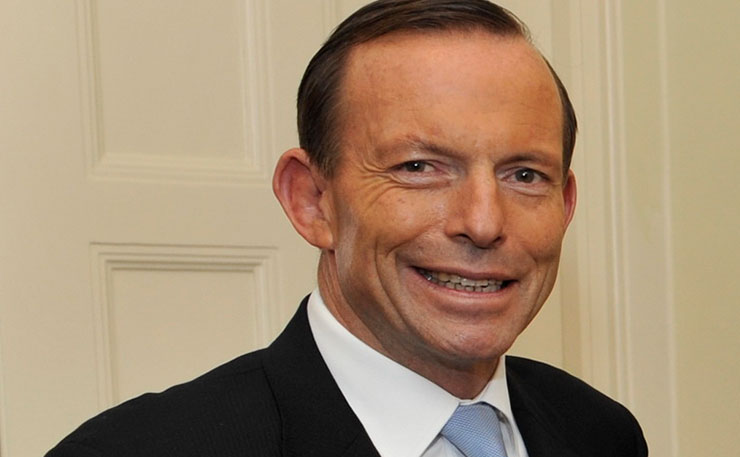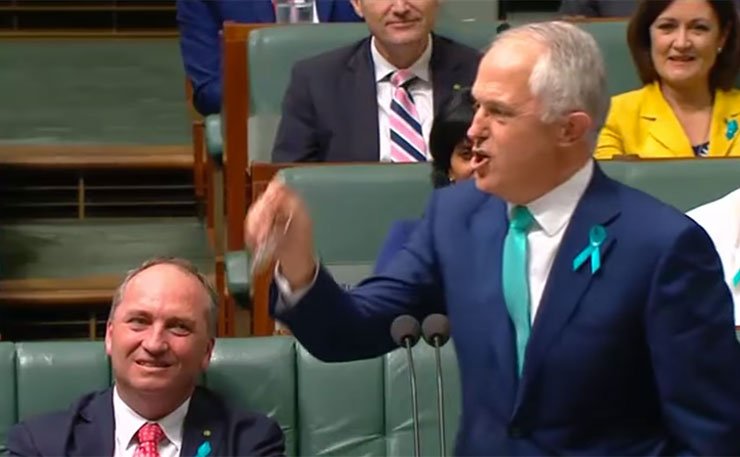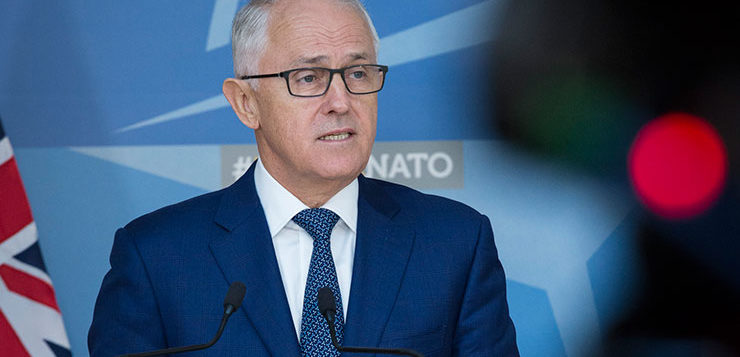This week’s challenge to Malcolm Turnbull’s leadership shows a Liberal Party on the brink of splitting apart, writes Ben Eltham.
The grand old Liberal Party is a venerable force in Australian politics. Founded by Robert Menzies from the ashes of conservative defeat during the second world war, the party has united anti-Labor political forces in this country for seven decades.
Although the party has moved steadily rightwards from its foundations as Menzies’ party of the forgotten people, it has always embodied what John Howard called a “broad church”, encompassing pro-business interests, small-l and classical liberals, religious and social conservatives, and a huge swathe of swinging voters in the Australian middle classes.
Unlike the notoriously centrifugal Australian Labor Party, which has split apart three times since 1916, the Liberal Party has never looked in serious danger of breaking up or splintering.
Until now.
Even for those accustomed to the bizarre shenanigans of major party politics in Australia, the past 48 hours have been extraordinary.

I’ll spare you the finer details, and simply state the obvious. Yesterday’s leadership challenge by Peter Dutton has destroyed Malcolm Turnbull’s prime ministership. There’s no way he can come back from this. He’s toast.
Only a truly gifted politician could escape from such a tricky crisis, and we should all know by now that Turnbull is not that person. Turnbull has let the initiative pass to his implacable enemies. They shall certainly make him pay.
In the short term, Turnbull will limp on. But a second challenge will come. At that point, Turnbull’s prime ministership will be officially over. But for all intents and purposes, it’s over already.
Turnbull’s destruction is the product of many factors, not least his own mistakes. As often happens in politics, the most important errors came early, when Turnbull baulked at calling an election to cement his own popular mandate as Prime Minister.
An election held in October or November 2015 would likely have been won handsomely by the Coalition, confirming Turnbull’s internal authority. Apart from anything else, it would have ensured an influx of first-term MPs who owed their seats in Parliament to the Prime Minister. It would also have enabled Turnbull to demand far greater discipline from the fractious Liberal backbench. Finally, it would have settled the question of which wing of the Liberal Party – moderate or conservative – truly ruled.
History shows that Turnbull did not call an early election, and instead stumbled and bumbled his way through the first half of 2016. He nearly lost the 2016 election, all but wiping out the Coalition majority, and killing off many of the moderate MPs he needed to control the party room. The result of 2016’s Pyrrhic victory was a second term for Turnbull, but a backbench controlled by his enemies. A gambler all his life, Turnbull sowed the wind. Now he reaps the whirlwind.
The fall of Turnbull is likely to become a seminal moment in Australian politics. It will reverberate for years, perhaps decades. Turnbull may be the last moderate Liberal leader for a very long time.

At the very least, it means the eclipse of the moderate wing of the Liberal Party that has ruled since Turnbull took over in 2015. Even if Peter Dutton does not ascend to the top job, as now seems likely, the conservatives have signalled that they are prepared to destroy a sitting prime minister and his government, in order to further their ideological interests.
All the dark predictions of the most Machiavellian observers have come to pass: the cynical destabilisation of Tony Abbott; the ever-rightwards ratchet of the backbench blackmailers; the jelly-like spinelessness of Turnbull’s response.
But Turnbull’s appeasement has not been entirely craven: he really has lacked the numbers on crucial policies, and the right of the Liberal Party really has held his government hostage. For these reasons, Tuesday’s moment was always likely to come. Unless Turnbull could vanquish his internal foes, they were always likely to destroy him.
For the Liberal Party as an institution, Turnbull’s downfall is an implosion of bewildering proportions. Right-of-centre governments are simply not meant to be this unstable.
The Turnbull government is not three years old; the Coalition government is barely five. It is not a particularly unpopular government. Recent polls have put the Coalition at a competitive 49-51 on two-party preferred terms. Voters tell pollsters that Turnbull is still their preferred prime minister over any other candidate, either Bill Shorten or anyone in his own party. The economy is improving; jobs are growing. On any sensible reading of the political situation, there is no pressing need for the Coalition to change leaders. What is required is patience and unity. But those are two qualities that this mob sorely lack.
Now that the challenge has happened, of course, the chances of a Coalition victory at the next election are diminished. The next opinion polls will be dire. They always are after an unsuccessful leadership spill. Voters hate disunity. If Turnbull lasts to the next opinion poll, of course.
The tactical folly of Monday’s leadership spill reveals something more: a fatal ideological rift in the Liberal Party. It is a rift that amounts to something close to a genuine split. The Liberal Party is now in open civil war, a conflict for the very soul of the party. For the Dutton faction, the political damage in the electorate seems incidental to the goal of destroying Turnbull and the moderates forever.

On the one side are the Turnbull moderates. If they are not exactly sensible centrists, they are certainly a group closer to the middle ground of the Australian electorate. On the other side are the insurgents backing Peter Dutton. These are the movement conservatives, the Sky News faction, many with documented links to the far right. Some of them are Abbott loyalists like Eric Abetz and Kevin Andrews, but a more significant group are made up of younger, ideologically motivated conservatives such as Andrew Hastie, Michael Sukkar and James Paterson.
As Tim Colebatch noted this week in Inside Story, the struggle for the future of the party is existential, even ontological. Colebatch notes that “in most of Australia, the Liberals’ shrinking party branches increasingly comprise a narrow base of cultural protesters rather than the broad base of mainstream Australians they had when national development was the issue.”
As I pointed out in an article about the rise of Australian far right, modern conservative thinking has moved rapidly in recent years. Amongst the contemporary conservative base, the onrush of tribalism has resulted in the abandonment of enlightenment values like scientific knowledge, liberal pluralism, or academic expertise.
As a result, movement conservatives quite literally live in a different reality to moderates and progressives, a world where conspiracy theories flourish, climate change is a myth, and western civilisation is under threat from immigrants, feminists and university lecturers.
In the longer term, genuine questions must be asked about the future of the conservative project. Can the Liberal Party continue in its current form? Will conservatives succeed in taking over the party machinery and melding it into a much more muscular, far-right apparatus – just as movement conservatives have done in the United States? Or will the party split apart?
In mainstream Australia, the endless culture war has so far been going very badly, as the marriage plebiscite showed. But the culture war within the Liberal Party has been another matter altogether: in the party machinery, the far right is winning.
As out of touch as the conservatives are with mainstream Australia, they are extremely in touch with the active and increasingly radical right. Indeed, it could be argued that this weeks’ events represent the logical conclusion of the radicalisation of the Liberal right.

It’s no coincidence that energy policy proved the spark that ignited the current Liberal conflagration. The passage of virulent climate denialism from fringe right-wing conspiracy theory to the centre of current Liberal policy shows just how radicalised the right of the party has become. Similar trends are apparent on issues like immigration. Such is the drift that a section of the party is more than willing to sabotage a sitting Liberal prime minister in order to secure political and ideological hegemony.
Such actions do not augur well for a sensible and balanced politics in this country. In fact, they suggest precisely the opposite: the rise of a powerful and dangerous far right movement, well on the way to taking over one of the two major parties in Australia’s democracy.
Donate To New Matilda
New Matilda is a small, independent media outlet. We survive through reader contributions, and never losing a lawsuit. If you got something from this article, giving something back helps us to continue speaking truth to power. Every little bit counts.




